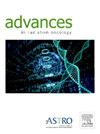Long-Term Outcomes of Multimodality Accelerated Partial Breast Irradiation for Ductal Carcinoma In Situ
IF 2.7
Q3 ONCOLOGY
引用次数: 0
Abstract
Purpose
To report long-term institutional outcomes for ductal carcinoma in situ treated with accelerated partial breast irradiation (APBI) using multiple modalities as a part of breast-conserving therapy.
Methods and Materials
From January 2001 to April 2019, 240 patients with stage 0 breast cancer were treated with breast-conserving surgery (BCS) and adjuvant APBI at our institution. Based on the 2024 American Society for Radiology and Oncology (ASTRO) APBI guidelines, 170 patients were “recommended,” 68 were “conditionally recommended,” and 2 were “not recommended” for APBI. A total of 102 patients were treated with linear accelerator-based external beam radiation therapy, 38 with magnetic resonance image-guided external beam radiation therapy (MRgEBRT), 49 with multicatheter interstitial implant (ISI) brachytherapy, and 51 with intracavitary applicator brachytherapy (strut-adjusted volume implant). Patients treated with external beam radiation therapy received 3850 cGy in 10 fractions twice a day. Patients treated with ISI or strut-adjusted volume implant received 3400 cGy in 10 fractions twice a day. Recurrence and survival were calculated using the Kaplan–Meier method. Cosmesis was scored by the Harvard criteria.
Results
At a median follow-up of 11.5 years (range, 1.2-17.8 years), the overall and cause-specific survival rates were 94.8% and 100%, respectively. The 10-year ipsilateral breast tumor recurrence rate was 3.8%. There were 9 observed ipsilateral breast tumor recurrences with 1 concurrent ipsilateral regional lymph node recurrence. No other breast failures, regional recurrences, or distant metastases were noted. Breast cancer–specific survival (BCSS) was 99.6% at the time of analysis. There was no statistically significant difference in overall survival or recurrence rates between the different treatment modalities. Cosmesis was excellent or good in 90% of cases without a statistically significant difference between the treatment method, 2024 American Society for Radiology and Oncology APBI criteria, or the 2022 American Brachytherapy Society (ABS) APBI acceptability categories.
Conclusions
APBI as a component of breast-conserving therapy for pure ductal carcinoma in situ is associated with excellent survival rates, local control, and cosmetic outcomes regardless of radiation therapy modality.
乳腺导管原位癌多模态加速部分放疗的远期疗效
目的:报道多方式加速部分乳房照射(APBI)作为保乳治疗的一部分治疗导管原位癌的长期疗效。方法与材料2001年1月至2019年4月,240例0期乳腺癌患者在我院接受保乳手术(BCS)和辅助APBI治疗。根据2024年美国放射与肿瘤学会(ASTRO) APBI指南,170名患者被“推荐”,68名“有条件推荐”,2名“不推荐”进行APBI。102例患者接受了基于线性加速器的外束放射治疗,38例接受了磁共振图像引导的外束放射治疗(MRgEBRT), 49例接受了多导管间质种植体(ISI)近距离治疗,51例接受了腔内应用器近距离治疗(支架调节体积种植体)。接受外束放射治疗的患者接受3850 cGy,分10次,每天两次。使用ISI或支架调节体积种植体治疗的患者接受3400 cGy,分10次,每天两次。采用Kaplan-Meier法计算复发率和生存率。《宇宙》是按照哈佛大学的标准进行评分的。结果中位随访11.5年(1.2-17.8年),总生存率为94.8%,病因特异性生存率为100%。10年同侧乳腺肿瘤复发率为3.8%。9例同侧乳腺肿瘤复发,1例同侧局部淋巴结复发。未发现其他乳房衰竭、局部复发或远处转移。分析时乳腺癌特异性生存率(BCSS)为99.6%。不同治疗方式的总生存率和复发率无统计学差异。在治疗方法、2024年美国放射与肿瘤学会APBI标准或2022年美国近距离放射治疗学会(ABS) APBI可接受类别之间,90%的病例美容为优或良,无统计学差异。结论sapbi作为单纯导管原位癌保乳治疗的组成部分,无论采用何种放射治疗方式,均具有良好的生存率、局部控制性和美容效果。
本文章由计算机程序翻译,如有差异,请以英文原文为准。
求助全文
约1分钟内获得全文
求助全文
来源期刊

Advances in Radiation Oncology
Medicine-Radiology, Nuclear Medicine and Imaging
CiteScore
4.60
自引率
4.30%
发文量
208
审稿时长
98 days
期刊介绍:
The purpose of Advances is to provide information for clinicians who use radiation therapy by publishing: Clinical trial reports and reanalyses. Basic science original reports. Manuscripts examining health services research, comparative and cost effectiveness research, and systematic reviews. Case reports documenting unusual problems and solutions. High quality multi and single institutional series, as well as other novel retrospective hypothesis generating series. Timely critical reviews on important topics in radiation oncology, such as side effects. Articles reporting the natural history of disease and patterns of failure, particularly as they relate to treatment volume delineation. Articles on safety and quality in radiation therapy. Essays on clinical experience. Articles on practice transformation in radiation oncology, in particular: Aspects of health policy that may impact the future practice of radiation oncology. How information technology, such as data analytics and systems innovations, will change radiation oncology practice. Articles on imaging as they relate to radiation therapy treatment.
 求助内容:
求助内容: 应助结果提醒方式:
应助结果提醒方式:


